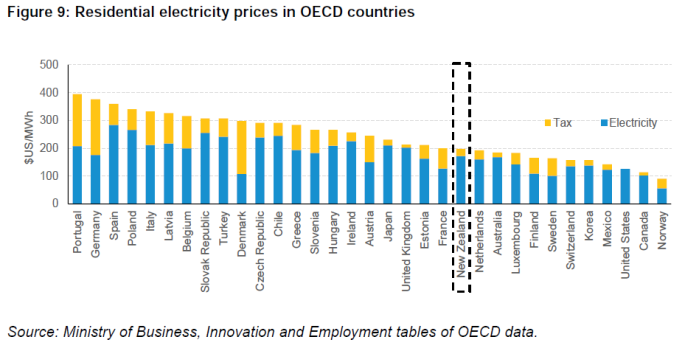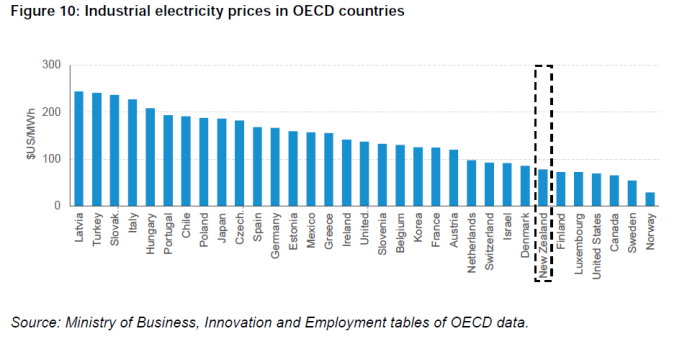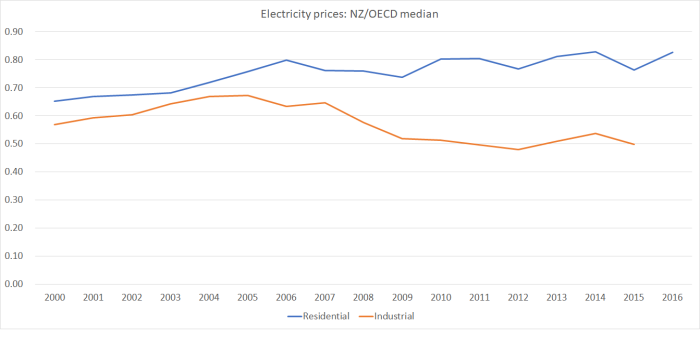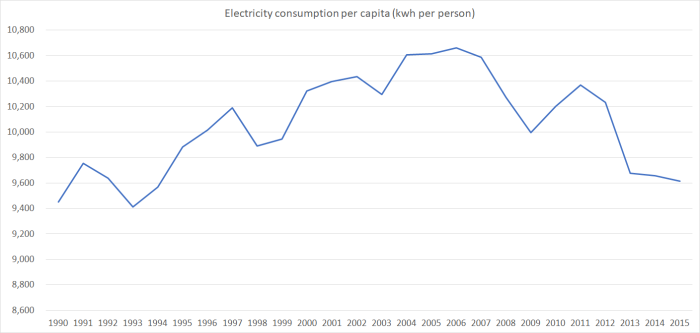I have fairly omnivorous interests but electricity, and the attendant policy issues, has never been among those interests. When the sector was being reformed 20 years ago, it was one of the topics – endlessly discussed on Radio New Zealand’s Morning Report – that I would simply zone out as I drove to work. I don’t know how much our household pays each month for electricity and without looking it up couldn’t even name who our supplier is.
I hear the stories that appear each winter about the pressure some people face as regards electricity costs. My (uninformed) presumption usually is that any issue is mostly about the shockingly poor rates of labour productivity in New Zealand, in turn reflected in the relatively low incomes the New Zealand economy supports, with some mix thrown in of changing tastes, poor disciplines, bad luck, and perhaps some issues at the margin around how the welfare system treats a handful of people. Life is tough at the bottom. Our “bottom” is so much worse than it need be, and successive generations of politicians should be held accountable for that.
But when the electricity review document was released the other day, I decided to dip into some numbers and see what I could find out. As has been highlighted repeatedly, there has been a big shift over recent decades such that residential user (real) power prices have risen substantially while commercial and industrial (real) prices have been pretty flat or even falling.
 So the argument goes, there was previously considerable cross-subsidisation in favour of domestic users. In particular, there has been a big change in how distribution costs are allocated.
So the argument goes, there was previously considerable cross-subsidisation in favour of domestic users. In particular, there has been a big change in how distribution costs are allocated.
 But how do New Zealand prices compare with those in other advanced countries? The review report has some charts showing those numbers, using OECD data (all national data is converted into USD using PPP exchange rates).
But how do New Zealand prices compare with those in other advanced countries? The review report has some charts showing those numbers, using OECD data (all national data is converted into USD using PPP exchange rates).
Here are household charges

Just focusing on the blue bars, the basic (ex-tax) electricity prices New Zealand households face is around those of the median OECD country. We are, of course, poorer and less productive than the median OECD country, so the burden of any of the necessities of life will tend to fall more heavily here than in many other advanced countries.
What about industrial prices? Here is another chart from the review.

New Zealand prices for industrial users are among the lower in the OECD.
The OECD data MBIE reports goes back only to 2000, but here is how New Zealand prices have changed relative to those of the median OECD country over that period for both the residential and industrial series (using only the countries for which there is a complete series of data).

For what it is worth, there hasn’t been much change in the blue (residential) line over the last decade.
I was interested not just in the medians, but in the countries with the lowest power prices. After all, it used to be something we boasted of here – one of the great advantages of life (and business) in New Zealand: one of the arguments for the establishment of Comalco decades ago. Norway, Canada, the US, Sweden, Finland, and Denmark (ex taxes) all have among the lowest electricity prices for both residential and industrial users. In Norway, in particular, both lots of prices are far far lower than those in New Zealand. And in Norway – notwithstanding all that oil and gas – something between 95 and 99 per cent (depending on which source you look up) of electricity generation is from hydro sources – where the energy source itself comes, in effect, free. The hydro+geothermal share in New Zealand also used to be above 90 per cent.
One reason why the hydro share of electricity production has dropped away in New Zealand is our relatively rapid population growth. There are only so many rivers (and environmental/political constraints on using more anyway) and lots more people.
For a long time, the biggest factor driving electricity consumption/production wasn’t the number of people, but their (per capita) demands to use electricity. I looked up an old yearbook. Between about (I’m eyeballing a small chart) 1942 and 1955 electricity consumption per capita doubled. Between about 1955 and 1971 it doubled again. MBIE data show that by 1996 it had doubled again. But here is the MBIE data on per capita electricity consumption since 1990 (sadly only updated to 2015).

Consumption per capita peaked in 2006, and in the most recent year was below the 10000 Kwh per capita first reached in 1996. But our population now is almost a third larger than it was in 1996, and all of us (well, a few hermits aside perhaps) need/use electricity.
The new SNZ preferred (and genuinely better) measure of net migration only starts from 2001 and is only available up to early 2017. But over just that period, net immigration of non New Zealand citizens – with the most aggressive (per capita) immigration policy anywhere over most of that period – has contributed directly 741000 new people of a total population increase in that period of 936000. All those people, natives and migrants, will have added to electricity demand.
Of course, the other factor that greatly influences the level of electricity production in New Zealand and, thus, the marginal price is the aluminium smelter at Tiwai Point, reported to consume perhaps 13 per cent of total electricity production. The smelter was kept open a few years ago only as a result of new taxpayer subsidies (described by sceptics from the left and right as “corporate welfare”).
It is hard not to think that if our politicians had not been so determined to keep Tiwai Point open, and so determined to rapidly drive up our population in a unpropitious location (and despite the complete lack of evidence of resulting productivity gains), electricity prices for all other users would be rather lower. Oh, and those with a renewables target in mind would have been able to rest easy too.
Then again, having adopted strategies that successfully lifted productivity – clearly requiring something different in key areas to the approaches followed here for decades – would also have eased the burden on poor households of electricity prices.
Of the 741,000 immigrants how many have had children? My own contribution was to arrive as a family of six and so far we have produced two newly minted NZ grandchildren and I’m hoping for more. Surely the children of immigrants can be added to your fraction of extra electricity users.
LikeLike
Yes, I agree the next generation is a factor (as in all past waves of inward migration – eg my great and great-great grandparents), altho I’m not aware of any work that has tried to quantify the effect in the more recent generation of migrants.
LikeLike
It is easier to leave them out but that leaves the stats biased towards immigrants because according to comments I see posted the stats have no taxpayer cost of education. Note the immigrants age and the cultural background make a big difference to likelihood of having children. Did anyone ever compared birth rates for immigrants from countries with a one child policy – I would have expected those who wanted larger families would disproportionately emigrate to countries that permit it?
I can understand that proud NZ citizen that I am, quite rightly I will always be an immigrant. My granddaughter born 13 years after her parent arrived is a 100% NZ citizen with no joint citizenships and has only ever lived in NZ.; however if NZ had stopped m arrival she would not be here consuming electricity, etc.
LikeLike
Welcome to the weird and wonderful world of electricity markets. Your comments reveal that you’re one of the ~50% of households who subsidize my electricity prices by not participating in the market by switching to cheaper retailers.
Your second to last chart shows that since 1997 households have subsidized industrial electricity consumers. This is probably a good thing, as industrial users create significant economic activity. Thoughts?
Think Big’s Clyde dam is responsible for 5% of our current electricity generation – so it wasn’t all bad. 4 more Clydes and we can be in renewable electricity utopia
LikeLiked by 1 person
Actually I read that chart wrong – it’s distribution charges, not price paid per unit of electricity. That makes sense, as local distribution companies were largely privatized and therefore have to generate returns.
LikeLike
Subsidies to industry (if they exist) are generally a bad thing, altho just possibly arguably (you sense my reluctance) perhaps offsetting in part the persistently overvalued real exchange rate.
But with a smaller population, and unchanged electricity policy regimes, probably all users would have had lower prices. Of course, lower prices are not automatically a good thing – had there been an influx of new highly productive and profitable outward-facing industries, power prices might well have been higher (we’d have to push further up the LMRC curve), but the nation as a whole would have been better off (and reflected over time in higher wages).
LikeLike
….hmm; there is quite a lot of fixed cost in the supply chain? higher number of households, lower fixed cost per household? NZ seems to have a large number of distribution companies – a merger or two might chip away at those fixed costs…?
LikeLike
Looks like NZ electricity forwards are trading about NZD80. If a developer can’t build a new wind farm for less than that something is very wrong. Wind developers can make money on PPA prices of AUD50s in Australia and below USD20 in America. NZ has better wind and a carbon price.
LikeLiked by 1 person
What you seem to be revealing in your opening paragraphs is that you are largely immune from the impacts of the higher inflation that bedevils much of the population. The tales of hardship from people struggling to pay electricity bills or who choose to be cold rather than blow the budget on expensive heating costs, is so far removed from your comfortable lifestyle that it attracts no more than a few dispassionate thoughts about life choices and a few laments over our low productivity. Could be seen as verging on condescension towards those who aren’t, aren’t yet, or never will be financially secure? For me the attitude doesn’t sit well with your relentless promotion of inflationary economic policies, and might explain why you find inflation to be relatively harmless? (If it was constricting your lifestyle, as it potentially does to many ordinary people I wonder if that would change.)
According to the CPI electricity prices have consistently exceeded the headline CPI measure. In fact, on average since the year 2000 electricity price inflation for consumers has been roughly double the headline CPI (4.3% vs. 2.1 percent). Electricity is an essential good both for the consumer and the producer, and in my view its pricing is something that should concern everyone. If this outcome is mainly as a result of cross-subsidisation being unwound then that would be useful information to know and have it laid out in a transparent manner by power companies. Which would lead in to the question of why such high increases might be continuing and persisting over 18 years at least, to this day. I’d suggest a lot of people would be very interested to know.
I do agree strongly with a fair amount of what you say, and I don’t suppose economists are well known for being particularly empathetic, but where policies are being promoted that stand to hurt a lot of people financially, maybe that quality could be a useful check against ideological fervour.
LikeLiked by 1 person
We probably all have our blindspots. I’m an assiduous bargain hunter at supermarkets, but don’t pursue electricity options. In part, that is probably a reflection of an economist’s prior that there are unlikely to be systematic advantages in investing search costs when purchasing an utterly homogeneous product (I might be wrong on that, but it is the implicit prior I think). Oh, and we heat with gas.
I guess my real point was that I am somewhat sympathetic to the stories one hears about electricity hardship, and yet when one looks into the charts in the review document, power prices here aren’t particularly high (something that doesn’t get much coverage). There is a good reason to think they could be lower – even if the current electricity regulatory framework is fine (something i have no view about) – if we hadn’t put so much population pressure on our limited hydro resource (without evident productivity gains that might in some sense “justify” the associated higher domestic power prices).
LikeLike
The dark art of deception
Last week on the nightly news it was announced that power costs have increased by 80% since 1990. The following day it was published that the 80% was after removing inflation. If you add back inflation the increase was 155%. By this time the accepted wisdom was 80%. The average Joe who comprise 80% of the peons wouldn’t understand the difference. The 80% increase announcement came out of a government review committee – that they sought to minimise the amount by curating it is political – don’t want the peons protesting – keep them bamboozled and uninformed
Cost of NZ electricity per kwh
80% of NZ power generation is renewable hydro at minimal ongoing costs
Auckland 26.90
Waikato 30.65
Bay of plenty 28.89
Wellington 28.03
Canterbury 27.89
Otago 27.19
https://www.canstarblue.co.nz/energy/average-electricity-costs-per-kwh/
80% of Australian power generation is coal fired at ongoing-costs
Australia – State – c/kWh
Queensland 27.05
New South Wales 27.74
Australian Capital Territory 19.68
Victoria 28.60
Tasmania 23.15
South Australia 32.31
Western Australia 27.17
Northern Territory 25.74
LikeLike
Electricity is a regressive tax.
In the year 2000 I was living in AU and more or less oblivious of the costs of electricity. What I was aware of was it was like constantly having someone’s hand in my back-pocket siphoning ever increasing amounts out of my pocket and being powerless to do anything about it.
In 2006 as part of the Copenhagen accord AU set about encouraging the population to install roof-top solar-power. The subsidies were so significant one couldn’t help but be interested to check it out
A close mate, a Phd who had been head-hunted from the UK Atomic Energy Commission, came to Melbourne University where an early project had been to examine ways to increase the energy yield from the La Trobe Valley Brown coal fields and their associated power stations. He did so but the Labour State Government buried the report. He turned his attention to the Australian Outback Solar Car Race and the university entrant. In 2006 I asked his opinion of solar panels. Short story, in 2007 having researched the offer for 6 months I went with a grid-tied 1.2 kwh roof-top installation. Seemed too good to be true. An government sponsored.
Left Melbourne in 2015 having had the benefits of solar power for 8 years since 2007. In those 8 years I did not pay 1 red cent in electricity charges. None. Zero
LikeLiked by 1 person
I phoned in on The Platform 23/08/24 (Michael Laws).
Michael Laws wasn’t having a bar of it and called me the Dan Brown of NZ by linking all those things. He asked me how I got like that (conspiracy theorist(?)) and I told him it was a talent I was born with.
Somewhat taken aback, I’ve been doing some reading; I see that geothermal has been developed, gas if falling off and there is still a bit of developable hydro. However the thesis still stands. (Michael’s post).
And just on another note I am appalled that (it seems), while we are being rammed into apartments, they are building the sort that fell down in the Christchurch Earthquake. The political system seems to exist in parallel universes. A while ago I phoned Duncan Garner on the Platform, it was a very different Duncan Garner to the one who enthusiastically agreed with Paul Spoonley and Michael Barnet on the AM Show.
LikeLike